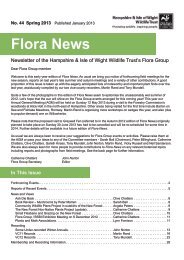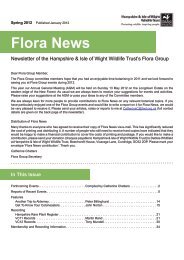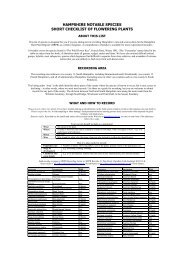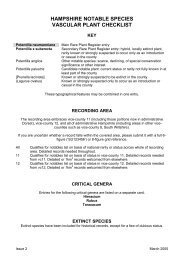An A5 booklet version as distributed in the - Hants Plants
An A5 booklet version as distributed in the - Hants Plants
An A5 booklet version as distributed in the - Hants Plants
Create successful ePaper yourself
Turn your PDF publications into a flip-book with our unique Google optimized e-Paper software.
Example 4: <strong>the</strong> really annoy<strong>in</strong>g model<br />
No, it’s not <strong>the</strong> fact that it’s <strong>in</strong> Spanish that makes this really annoy<strong>in</strong>g, It looks like a<br />
Stace key (apart from <strong>the</strong> fact that <strong>the</strong> top couplet isn’t numbered), but look what<br />
happens at couplets 2, 3 and 4. One choice keys out at couplet 3, but you <strong>the</strong>n have to<br />
play leapfrog over couplet 4, <strong>the</strong> next two choices that came from <strong>the</strong> o<strong>the</strong>r half of<br />
couplet 2. As <strong>the</strong> key goes on for ano<strong>the</strong>r page, this game of leapfrog just gets more<br />
and more contorted. There is no way to see at a glance which species share a common<br />
diagnostic feature.<br />
Multi-access keys<br />
Dichotomous keys work f<strong>in</strong>e for plants that can be dist<strong>in</strong>guished on a small number of<br />
clear-cut diagnostic features. They work less well when <strong>the</strong>re are subtle overlaps and<br />
a comb<strong>in</strong>ation of characters needs to be taken <strong>in</strong>to account; or when some of <strong>the</strong> ma<strong>in</strong><br />
dist<strong>in</strong>guish<strong>in</strong>g characters may be difficult to observe.<br />
The pr<strong>in</strong>ciple beh<strong>in</strong>d a multi-access key is that one makes a choice from several<br />
different sets of attributes, and this gives one a code made up of a str<strong>in</strong>g of <strong>the</strong>se<br />
choices. One <strong>the</strong>n looks through a table to match <strong>the</strong> code <strong>as</strong> closely <strong>as</strong> possible to a<br />
plant species. One can’t always get a complete code, but hav<strong>in</strong>g just a few uncerta<strong>in</strong><br />
44<br />
Rhombic A flat shape longer than wide, widest at <strong>the</strong> middle and angled at<br />
that po<strong>in</strong>t, with more or less straight marg<strong>in</strong>s runn<strong>in</strong>g to <strong>the</strong> b<strong>as</strong>e<br />
and apex (i.e. roughly diamond-shaped)<br />
Rostrate With a beak<br />
Runc<strong>in</strong>ate With sharp lobes or divisions directed backward towards <strong>the</strong> b<strong>as</strong>e<br />
Sagittate Shaped like an arrow-head at le<strong>as</strong>t at <strong>the</strong> b<strong>as</strong>e<br />
Spathulate Spoon-shaped<br />
sub- (In front of ano<strong>the</strong>r shape term) weakly, <strong>in</strong>dist<strong>in</strong>ctly or imperfectly:<br />
e.g. subcordate, with shallow heart-shaped b<strong>as</strong>al lobes; subglobose,<br />
not quite spherical<br />
Subulate Taper<strong>in</strong>g evenly from <strong>the</strong> b<strong>as</strong>e to a f<strong>in</strong>e po<strong>in</strong>t at <strong>the</strong> apex<br />
Terete Rounded <strong>in</strong> cross-section<br />
Transverse Ly<strong>in</strong>g cross-ways, with <strong>the</strong> po<strong>in</strong>t of attachment on a side<br />
Triangular Hav<strong>in</strong>g three more or less straight sides (and <strong>the</strong>refore truncate at<br />
<strong>the</strong> po<strong>in</strong>t of attachment when attached by <strong>the</strong> marg<strong>in</strong>)<br />
Trigonous With three angles <strong>in</strong> cross-section<br />
Triquetrous With three more or less sharp angles <strong>in</strong> cross-section<br />
Trullate A flat shape widest near <strong>the</strong> b<strong>as</strong>e and with straight sides runn<strong>in</strong>g<br />
towards b<strong>as</strong>e and apex (i.e. trowel-shaped)<br />
Truncate Cut off <strong>in</strong> a straight l<strong>in</strong>e at ei<strong>the</strong>r <strong>the</strong> b<strong>as</strong>e or <strong>the</strong> apex<br />
Unguiculate Narrowed at <strong>the</strong> b<strong>as</strong>e <strong>in</strong>to a claw<br />
Urceolate Urn-shaped or pitcher-shaped<br />
Tooth<strong>in</strong>g and lob<strong>in</strong>g<br />
Bidentate Hav<strong>in</strong>g two teeth; or hav<strong>in</strong>g teeth of two different sizes<br />
Biserrate Hav<strong>in</strong>g saw-teeth of two sizes<br />
Crenate Hav<strong>in</strong>g rounded teeth<br />
Dentate Too<strong>the</strong>d<br />
Denticulate F<strong>in</strong>ely too<strong>the</strong>d<br />
Entire Not too<strong>the</strong>d or lobed<br />
Fimbriate With <strong>the</strong> marg<strong>in</strong> cut <strong>in</strong>to long slender lobes<br />
Lacerate Jaggedly and irregularly cut<br />
21







